In the syllabus for his Engineering, Design and Social Justice course, Ben Lutz makes clear that students must use evidence to support claims made during classroom discussions.
With a topic than can be emotionally charged, he said it’s good to let to students know from the outset that social justice in engineering represents an area of scholarly inquiry, with scientific methods for discussion.
“We’re not just talking about how we feel,” Lutz said. “When we talk about inequities, we want to come up with evidence, and I want students to know there is evidence out there.”
Lutz suggested the class after the murder of George Floyd sparked wide discussions on racial inequity and social justice. While the killing of Floyd and other Black people brought attention to inequities in law enforcement responses, the events have also drawn attention to the way other fields address existing inequities.
“I think the timing was right for something like this,” said Lutz, who was one of 16 tenure-track assistant professors hired campus-wide in 2019 to promote inclusive teaching strategies.

Lutz’s new course, which he taught for the first time in the spring of 2021, aims to show how engineering designers and design processes both shape and are shaped by societal forces. Those forces, the course notes, can result in biased designs.
A popular example on the internet is an automatic soap dispenser designed with a sensor that only recognized lighter skin, seeming to discriminate by not dispensing soap to those with darker skin tone. Other examples, Lutz said, occur in facial recognition technology, algorithms used in predicting recidivism or artificial intelligence used in hiring decisions.
Those biases are usually not intentional but reflect a lack of diversity in design teams or designers that overlook the broad range of stakeholders that might be affected by the design.
His class looks at promoting equity in the process and the outcome by looking at the factors that go into design and the impacts they might have. The course also touches on other issues at the intersection of engineering design and society, including the environmental impact designs have and the ethics of designing for the defense industry.
Student Sarika Singhal said the elective made her more aware of the dynamics that gender can play in engineering.
“For example, when I work with a team that is mainly guys, I have found myself more likely to be recording data rather than using the hardware unless I really advocate for myself,” said Singhal, who eventually wants to work for a company that promotes social justice within the company and with its products.
I learned that changing these ways of thinking starts with us, the engineering student body, questioning if engineering needs to be ‘the way it is’.”
Dominick Trageser, mechanical engineering student
In engineering, there is an assumption that men are better at technical skills and math, said Maisha Zaman, another student.
“This is so normal that men and women unconsciously internalize it, making the workplace more homogenous and unwelcoming,” she said.
Dominick Trageser had previously considered some of these concepts while performing diversity and inclusivity research with Lutz.
“I learned that changing these ways of thinking starts with us, the engineering student body, questioning if engineering needs to be ‘the way that it is,’” he said. “So when I heard that Ben was offering a class that would explore the intersections of engineering and social justice, I was very excited to sign up.”
He found discussions of reframing engineering as a social justice practice especially powerful.
“Often topics of social justice are seen as irrelevant to engineering practice when we attribute inequalities to the myth or meritocracy in the U.S. and view our jobs as engineers as simply making things,” he said.
In the future, Zaman hopes to remember the importance of different human factors when it comes to producing products. That includes understanding different customers, including those from marginalized groups.
After a tumultuous year in U.S. history that included a devastating pandemic, high-profile examples of racially motivated police brutality, and an attempted insurrection, Zaman wanted to learn more about how engineering can have a positive impact.
“As of right now, I believe that if an engineer can maintain professional, ethical responsibilities, understand possible consequences of the solutions they create and take into consideration human-centered design factors, they can help improve and change the world for the better,” she said.


